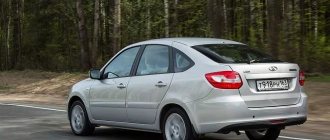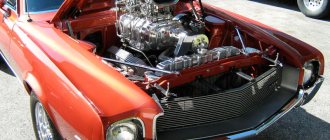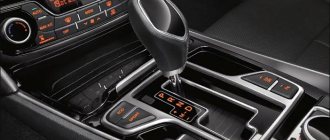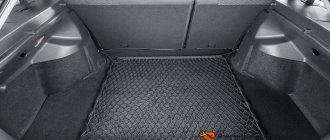The types of car bodies raise questions, for example: what is the difference between a liftback and a hatchback, what is the difference?
Over the past two decades, the domestic automobile market has expanded significantly, and many cars have appeared that are difficult to classify as any body type. Experts, of course, will easily classify a body to a certain type, however, it is very difficult for a person who does not work in the automotive industry to do this. Therefore, this article will focus on discussing the differences between a hatchback and a liftback.
We will also try to determine for what conditions and purposes such bodies are made, and why sedans, unusual for everyone, are so rapidly filling the roads. These body models are very common today, especially common in cities. An unenlightened person will almost immediately classify these models into the same class.
Two-door sedan originally from the USSR
There are technologies that make it difficult to manufacture B-pillars. In such cases, preference is given to the following options: coupe, two-door sedan, three-door hatchback or liftback. In order for the structure to be durable, the body must be three-volume (sedan, coupe). If we are talking about a mass-produced car, a sedan with two doors remains a suitable option.
The Zarya car project, which appeared in 1966, was developed by specialists from the Severodonetsk auto repair base. The body of this car, made of fiberglass, was mounted on a metal frame. Unfortunately, it was not possible to implement the project to the end, that is, to reach significant production volumes. The technology for producing fiberglass parts turned out to be too labor-intensive. But the car shown in the photo, and other “plastic cars” developed in the USSR at different times, were just two-door sedans. Which is 100% consistent with the ideology discussed above.
Over the past decades, the domestic market has been filled with a huge number of cars that cannot always be confidently classified. Understanding the products of the modern automobile industry can be difficult for non-specialists. Therefore, we have prepared for our readers an article-review of two popular types of passenger car bodies: liftback and hatchback.
So, what is the difference between a liftback and a hatchback and what are their advantages over conventional sedans? For what purposes were these bodies developed? We answer the most frequently asked questions in this post.
In conditions of dense city traffic, increased demands are placed on the car - it must combine comfort and maneuverability.
Sedans, which practically reigned supreme on the roads of big cities in the 20th century, do not always meet the needs of modern drivers. In particular, due to their length, it can be inconvenient to park along the road and move in heavy traffic from lane to lane.
The solution was found by radically changing the car configuration:
- the luggage section was combined with the cabin;
- the rear overhang has been significantly shortened;
- A front-wheel drive system with a transversely mounted engine became standard.
New cars acquired the name hatchback ( eng.
hatch = hatch) thanks to an innovative design with a rear door through which access to the luggage compartment was provided. Today, cars of this type are produced in both 5-door and 3-door configurations, and are popular among Russian motorists.
Separately, it is worth noting that such models are much better than a sedan for novice drivers, since they are easier to get used to the dimensions. If you are choosing your first car, then this is your choice.
Unfortunately, hatchbacks have some disadvantages that owners need to take into account - in the event of an accident, the contents of the trunk can “fly” into the cabin and injure passengers sitting in the rear seats. A special mesh covering the cargo compartment will help prevent accidents. In addition, keep in mind that unpleasant odors from luggage can also lead to serious discomfort during long rides.
What is better to choose
For domestic consumers, both hatchbacks and liftbacks are of interest as cars for urban conditions, which are much more convenient than a sedan due to their dimensions and design solutions
The two body types described above can be safely classified as passenger cars. If you compare them with each other, the following differences will become noticeable:
- The liftback is almost identical to the sedan, since it also has an extremely long rear overhang.
- The hatchback is equipped with a single-volume body - the trunk and interior seem to be an ode to the whole component.
- The liftback is produced in different versions of the rear door opening.
- Liftbacks can be either two-volume or three-volume.
Hatchbacks are much better suited for novice drivers than sedans, since they are easier to get used to the dimensions.
Upon visual comparison of the above models, it will become clear that the rear element of the hatchback is without protrusions and is almost perpendicular to the ground. But not everyone likes the appearance of a hatchback and its respectable size, which is why liftbacks are in particular demand.
Thus, these versions are characterized by many differences, so they are selected by users depending on preferences
Those who are burdened with a family and need a small car for the city pay attention to the hatchback. If you want to buy a large car, but a sedan is not suitable due to the size of the luggage compartment, then people turn their attention to liftbacks
Have you ever wondered how a liftback differs from a hatchback? Nowadays, there are so many varieties of cars that it is sometimes impossible to keep track of them. If you are not an expert in auto topics, then understanding the classifications of modern cars is an extremely difficult task. Therefore, a review article about the two categories of machines will be very helpful.
What is the difference between a liftback and a hatchback and what are their advantages? Are they better than regular sedans or are there radial differences? To understand this, you need to at least superficially get acquainted with each of them.
Hatchback is a car for big cities
Often, large cities are replete with all kinds of vehicles; it is simply impossible to get through there during peak hours. In these conditions, the average user needs a car that has good maneuverability and comfort.
In the last century, sedans ruled the roads, but they are not very suitable for current conditions. They are too long, and it is extremely inconvenient for the driver to park along the highway, as well as navigate endless traffic jams.
Hatchbacks are created specifically for such conditions, and cope with the assigned tasks perfectly. These cars have the following distinctive features:
- The luggage section and interior space are combined;
- They have a shortened rear part;
- They are front-wheel drive, and the engine is located transversely.
The new cars are called hatchbacks, which means hatch in English. They have a modernized design with an additional door at the rear, which gives access to the trunk. Configurations with five and three doors are common, which makes them popular both in the Russian market and in all countries of the world with large populations.
Such a car would be ideal for a novice driver, as it is small and easy to control its dimensions. Therefore, a hatchback is an ideal choice as a first car.
The disadvantages of these cars include their unsafety during an accident. The combined trunk and interior in this case pose a danger, because the contents of the luggage compartment can cause injury to passengers. It is recommended to play it safe and block off the compartments with a special protective net. In everyday life, foreign odors may penetrate from the trunk; this also needs to be taken into account.
Liftback is a car that can transform itself
About configurations
In the most budget configuration, “Standard”, the car is equipped with a 1.6 liter, 87-horsepower engine, manual transmission, ISOFIX fastening system, central locking, driver airbag, child lock.
The “Norma” version of the Lada Granta liftback offers two engine options: the first – with a volume of 1.6 liters and a power of 87 hp, the second – with a volume of 1.6 liters, but with a power of 106 hp. Also included in the package are ABS and BAS systems (brake assist), an on-board computer, electric power steering, electric windows on the front doors and a multimedia system.
The Lada Granta hatchback, despite the original “low cost” concept of the car, was able to acquire a “Lux” package with interesting characteristics. A 98 hp engine is available in the luxury package, and most importantly, it can be combined with an automatic transmission. In addition, a stability control system, fog lights, an airbag for passengers, heated front seats and a climate system become available. See also the Grants liftback equipment table.
Read more: How to check the steering rack on a Solaris
Comparison of Lada Granta liftback and sedan
We decided to find the differences between the two Granta bodies and started with safety. The creators carefully approached the issue of revising the body design. Since the hatchback is inferior to the sedan in terms of resistance to lateral loads, it was decided to strengthen the roof, arches and wings, and increase the overall thickness of the floor sheet. If you compare the Lada Granta with the Samara, which the liftback replaced in the AvtoVAZ model range, the body has become twice as rigid, and accordingly, the model has become safer.
Together with Renault-Nissan specialists, the luxury car has a modernized suspension with gas-filled shock absorbers, thicker stabilizers and stiffer springs. Other trim levels come with the standard sedan suspension.
One of the main distinguishing features of the Lada Granta is the spacious trunk for both a liftback and a hatchback. And although at first glance it is smaller than that of the sedan - 480 versus 440 liters, when folding the rear seats its volume increases by more than one and a half times (760 liters). These figures significantly exceed those of the Lada Kalina, the trunk limit of which stops at 670 liters.
The interior of the Lada Granta has remained virtually unchanged compared to its sedan predecessor. The same console, instrument panel, the same seats. There is enough space in the back seat for three passengers to feel quite comfortable. The only question is the space above your head. If your height is 190 cm or less, you will be comfortable, but taller passengers will find the car uncomfortable.
When conducting test drives of the Lada Granta liftback, many drivers noted that the combination of a powerful engine and relatively low weight (1070 kg) provides decent dynamics for an inexpensive car. The main thing is not to accelerate the car above 150 km/h, since handling and directional stability at top speeds are not at all impressive. With a quiet ride, thanks to the elastic suspension, which is optimal for our roads, the Lada Granta leaves the most pleasant impression.
The brakes can also be praised with flattering words, both during emergency and normal braking. But the advertised sound insulation raises complaints: when driving dynamically, the cabin is noisy, and you have to speak much louder to have a conversation. Installing additional sound insulation will solve the problem.
Average fuel consumption in the city with a manual transmission is 7.9 liters per hundred kilometers, while on the highway it is one liter less. “Automatic”, of course, is more voracious: on average 9.6 liters per hundred kilometers in the city and 8.5 on the highway. However, these are quite modest figures.
To summarize, we can say that, despite certain shortcomings, the Lada Granta liftback fully justifies its price and has every chance of becoming a bestseller among economy class models. Finally, video review of the Lada Granta hatchback:
By the way, do you know that in our Club you will find many instructions on how to modify, repair or tune the Grant Hatchback.
Photo source:
Website kolesa.ru
Transformations affecting the chassis and body components
The manufacturer made every effort to eradicate the flaws inherent in the sedan.
The Lada Granta configurations in the “Standard” and “Norma” versions have acquired new settings in the suspension, where a special role is given to modified shock absorbers. The springs were carried over from the sedan. The suspension has become more suitable for country roads. Here passengers perceive bumps and potholes more comfortably.
The luxury equipment will delight you with a new suspension design, where a powerful stabilizer and rigid spring elements are located as a separate link. This solution is aimed at increasing stability and reducing amplitude during rolls.
Also, you should not ignore the gas-filled shock absorbers, which were previously equipped exclusively with LADA sports cars. The brake unit has increased responsiveness and information content due to the use of an updated vacuum booster.
The ground clearance has increased by 15mm, which will be especially gratifying for those who like to conquer off-road terrain.
If we compare, the design of the liftback does not imply the presence of a body-strengthening bulkhead located in the stern. The rigidity of the body frame was increased by strengthening the underbody and roof panel, as well as making adjustments to the design of the middle spar.
Liftback or sedan?
The most visible differences between the Lada Granta liftback and sedan, described above, enable the potential owner to make a more precise choice. The main difference between the two cars is the external design. Compared to the Grant liftback, the sedan looks boring and dull. Despite the fact that in our country sedans are treated much warmer than hatchbacks and other body styles, most owners of the four-door Granta shrug their hands dejectedly: if they had known that the hatchback would turn out to be so successful, they would have delayed the purchase.
But the list does not end with those changes that are visible to the average buyer. In addition to the fifth door, updated design and equipment, the Granta liftback received many technological innovations. Firstly, AvtoVAZ designers tried to correct as much as possible the flaws that plagued the Granta sedan (the automaker’s employees learned about the main complaints from the relevant forums on the Internet). So, the fastening screws were replaced, which in the four-door Grant simply crumbled from corrosion.
Secondly, the use of a new seal and door stop with a closer effect made it possible to solve the problem of creaking when opening and rattling of glass on the rear doors. Significant work has been carried out on noise insulation, which can be especially felt by machine owners. In this regard, the liftback is much quieter. The liftback's braking system has also been optimized. The vacuum brake booster received by Granta liftback made the brake pedal more responsive and precise. Braking is no longer as harsh as on a sedan; pedal travel is reduced.
The problem with body rigidity has been resolved. Due to the design features of five-door cars, this issue was quite relevant when developing a liftback. The fact is that hatchbacks, unlike sedans, do not have a reinforcing rear bulkhead. This problem was eliminated by strengthening the liftback roof and the floor in the middle of the cabin; The way the vehicle's middle spar structure is reinforced has also changed.
The most significant improvements affected the chassis of the Granta liftback. Moreover, the changes affected not only the top-end configuration, but also the “standard” and “norm”. In the minimum and medium configurations, the cars received an improved suspension with liquid shock absorbers, and the springs were borrowed from the Granta sedan. The suspension settings for the liftback have been changed. This suspension is not so precise in control, but it is easier for it to work off-road, and passengers do not shake so much on potholes and bumps.
The Grant liftback “luxury” version has a fundamentally new suspension, which appeared at the beginning of 2014. It uses much more powerful anti-roll bars, both front and rear, compared to the sedan: stiffer springs and gas-filled shock absorbers. In general, it turns out that the liftback’s suspension is intentionally stiff.
The designers decided to sacrifice passenger comfort in order to improve handling. A rigid suspension allows you to increase the stability of the car during sharp turns, reduce roll and sway. Basically, the new suspension is designed for a younger audience, for whom it is much more important to get high handling from the car than comfort.
In conclusion, it should be said that all the technological innovations that distinguish the Granta liftback so favorably will soon be transferred to the sedan of the same name. The only exception will be a rigid suspension; it will not be on the sedan. According to data from AvtoVAZ, restyling of the entire Grant family is planned for 2016, and time will tell how liftbacks and sedans will differ.
Every driver has an idea of what a hatchback, sedan or station wagon looks like. This is not news, because these body types are considered the most popular. However, even the smartest car enthusiasts sometimes do not know the exact definition of a Liftback body. Liftback: what is it? Let us explain the main differences, advantages and disadvantages.
A liftback is a specific type of body that is several times more practical than a sedan, has a spacious trunk and folding rear seats, which makes it possible to load larger items. It has a streamlined shape, which has a positive effect on aerodynamics.
Hatchback parameters
This type of body has been developed since the middle of the last century. Its name contains two English words “hatch” - hatch and “back” - rear. In fact, this describes the presence of a door on the rear side of the car. This door is not used for boarding passengers, but for comfortable stowing luggage or cargo.
Manufacturers offer both three-door and five-door hatchback models. The main design solution is to combine the luggage area located at the rear with the passenger compartment into a single space. Thus, the result is a two-volume car, in contrast to a three-volume sedan.
A nice bonus for hatchback owners will be the presence of reduced rear overhangs, which not only makes parking better, but also makes it easier to maneuver in confined spaces. Characteristic features include the presence of front-wheel drive and a transverse engine arrangement .
It is advisable to look at the hatchback and liftback from the side; you can see the difference between them from this angle. In a hatchback, the fifth door runs from the roof to the signal stops in a smooth line, without sharp bends. The profile of such a case is close to a teardrop shape.
We recommend: Which crossover is the most reliable, economical and inexpensive?
Four reasons to buy a sedan instead of a liftback and one not to do it
If anyone has forgotten, a liftback is a kind of hybrid of a sedan and a hatchback. That is, the car looks like a four-door car, but has a trunk door, like a hatch, that opens along with the glass.
Will it fit or not?
By the way, the presence of a fifth door is the main advantage of a liftback over a classic sedan: it opens wide access to the luggage compartment. So you can also load large luggage there. Of course, it should not exceed the available space in size.
But let’s not include in the column of undeniable advantages of a liftback over a sedan such an item as the ability to fold the backs of the rear seats in order to increase the volume for luggage. Even four-door cars can do this, although not all of them can. Therefore, the long ones will fit quite well in the sedans that our brother has loved since Soviet times.
Body rigidity
If we talk about body rigidity, the sedan clearly has an advantage here; it is added by a cross member between the rear pillars, located under the lower edge of the glass. Due to the presence of a fifth door, so convenient for loading luggage, the liftback lost this element. Which, accordingly, negatively affects the behavior of the car while driving on a not very smooth road.
Cold and dust
Another plus of the sedan is the trunk, separated from the passenger compartment, which does not contain unpleasant odors, as well as dust from the cargo being transported. Of course, this problem is specific: not everyone and does not always carry something foul-smelling with them. But this can also happen.
The cold in winter is of the same order: in a liftback it easily penetrates into the cabin if you open the trunk for loading or unloading. This question is especially relevant for those who travel with small children. For caring parents, this factor is often the deciding factor when choosing a car. The main thing is not to give your baby a cold.
Liftback
When describing cars, we mainly use vocabulary that came to us from the English language: hatchback, injector, bumper, accelerator, parking, and so on. Quite often in the characteristics of certain cars you can find the name of the body - liftback. What it is? — Let’s try to sort this issue out.
A liftback is a type of hatchback, but unlike it, the car's profile resembles that of a sedan with a rear overhang, while the trunk door opens like a hatchback. It may not seem very convenient, but the standard liftback is superior in space to both a sedan and hatchback of the same size, but inferior to a station wagon.
Other names often used:
Thus, the liftback is a transitional link between a hatchback and a sedan, that is, the rear silhouette has a sloping, stepped shape. As you can see, the difference is small, but due to the fact that the rear door tilts up, it is easier to place bulky cargo in the trunk. The rear sofa folds down, which triples the volume of the luggage compartment. If you frequently transport various cargo, consider purchasing a liftback vehicle.
It is worth noting that even in the Soviet Union similar cars were produced. The very first domestic liftback was IZH-2125, known as “Kombi”.
Examples
Czech Skoda produces many models with this body type:
- Skoda Rapid;
- Skoda Octavia (A5, A7, Tour);
- Skoda Superb.
Czech cars are famous for their reliability and excellent performance. The Skoda Octavia is a great car for both work and family trips. Thanks to the presence of a liftback body, it can be filled almost to capacity with payload. Well, the Skoda Superb is a D-class executive car.
In 2022, German Volkswagen presented the Arteon fastback to the public. This is a full-size five-door car from the Gran Turismo series, which looks very impressive. The car belongs to the E-class, that is, it is intended for businessmen who have to spend a lot of time on the road.
It is worth noting that a fastback is a type of liftback. The roof can go into the trunk either sloping or with a slight overhang. As a rule, Premium class cars are equipped with a fastback body. So, the brightest representatives of fastbacks:
- Audi A7 Sportback;
- BMW 6 Gran Turismo;
- BMW 4 Gran Coupe;
- Porsche Panamera, including a hybrid version of the Porsche Panamera E-Hybrid.
We recently wrote on our portal Vodi.su about electric cars, and in 2009 the Tesla S Model liftback was presented to the public. This car looks very elegant and at the same time aggressive. It is not officially sold in Russia, but in Germany it will cost approximately 57-90 thousand euros, the price depends on the capacity of the batteries and the power of the power units. Characteristics deserve a separate discussion (for Tesla S Model P100D):
- 613 kilometers of range on a full charge;
- the power of both engines - rear and front - is 759 hp;
- speed 250 km/h (limited by the chip, in fact exceeds 300 km/h);
- it accelerates to hundreds in 3.3 seconds, and to 250 km/h in about 6-8 seconds.
Other more affordable liftbacks include the following models: Chery Jaggi, Chery A13 and Chery Amulet, Opel Insignia Grand Sport, Opel Ampere, Ford Mondeo Hatchback, Opel Vectra C Hatchback, Mazda 6 Hatchback, Seat Toledo, Renault Laguna Hatchback, Renault Vel Satis etc. The model line is constantly expanding.
Domestic liftbacks
In 2014, production of the domestic liftback Lada Granta began. Buyers were attracted not only by the silhouette of the rear of this car, but also by the modified shapes of the front bumper and rear doors. Even today, it is actively sold in the showrooms of official dealers at prices ranging from 414 to 517 thousand rubles.
- five-door body, interior seats five people;
- front-wheel drive, ground clearance 160 mm;
- 1.6 liter petrol engine with 87, 98 or 106 hp;
- in the city it consumes an average of 9 liters of A-95, in the country about 6.
Well, and of course, it is impossible to pass by such a famous liftback, even if not made in Russia, like the ZAZ-Slavuta. The car was produced from 1999 to 2006 and became one of the most affordable in the budget segment. It was equipped with a 1.2 liter engine with 43, 62 or 66 hp. For a small business it was an ideal car. Another liftback is being produced in Ukraine - ZAZ Forza, which is a modernized version of the Chinese Chery A13.
Source of the article: https://vodi.su/liftbek/
Price
The minimum equipment level of the liftback is rated higher than the “Standard” version found in the sedan. More specifically, you will have to pay 314.8 thousand rubles for the liftback. Whether it is rational to overpay for the improvements indicated here is up to the buyer to decide.
The manufacturer plans to equip the sedan with the options present in the liftback in the near future. The restyling process for the LADA Granta is expected to be carried out this year. Today, the liftback has a number of undeniable advantages over the sedan regarding the exterior and driving parameters, but still, which is better, everyone chooses for themselves. When choosing a suitable modification, you should first study the full list of features. It is also not recommended to neglect your own priorities and preferences. Consider the difference between modifications not only in characteristics and equipment, but also in a financial sense. If you are willing to pay more for a presentable design, interior improvements and slightly increased performance, then the liftback is your option. But in fairness, we note that today the liftback is brighter and more balanced in comparison with the sedan, and this allows us to mark it as the leader of our review.
Lada Sedan, after its “loud” entry into the market back in 2011 and an equally noisy PR campaign, managed to win love throughout Russia. From approximately 2011 to 2013, every second passenger car purchased was a Sedan from the Lada Granta. Orders grew... And it was their growing number that forced AvtoVAZ to optimize production and introduce some new items into the updated model.
In 2014, Lada Granta returned to the market with an updated Liftback body. The updates didn’t end there: the design and some structural elements also underwent changes. When something new comes out, people generally buy it “new”, but is the “new” always better? Or is this “new” actually a modified “old”?
Created in 2011, so distant for us, the Lada Sedan was distinguished by the variety of choices of its configurations, suitable for different requirements, from the appearance of the interior to the “filling”.
It is clear that from “Standard” to “Luxury” there are completely different price categories, but still there is a lot in common between them, namely: cheap design (one look at the side mirrors and low-quality plastic on the dashboard can tell a lot about the integrity of the designers AvtoVAZ), but at the same time, the interior was very spacious (a person 1.95 m tall can comfortably sit in a car), and the trunk was very, very pleasing with its volume - as much as 520 liters, and this despite the fact that for this you do not need to move anything away, remove or etc.
Considering the relative cheapness of the car (the average price of a new Lada is 420 thousand rubles), one can understand that the maintenance of the car will be appropriate. Starting in 2012, a modification was added: a four-speed automatic transmission from the Japanese manufacturer Jatco. But the surprises didn’t end there; however, they started getting unpleasant: tens of thousands of cars were recalled in 2013 due to problems with airbags.
Main differences between bodies
Both modifications are characterized as passenger cars with the driving performance and technical characteristics of a sedan of the corresponding model range. However, a liftback differs from a hatchback in the following ways:
- the rear overhang is shaped like a sedan;
- the liftback has two ways to open the doors;
- Unlike a two-volume hatchback, a liftback can be three-volume, more similar to a sedan.
Some manufacturers, not limiting themselves to this list of differences, are carrying out enhanced modernization of the series.
Using the example of the Lada Granta liftback, you can see that along with the new forms, the chassis and braking systems in the car were modernized. Without tying such a change to the body, the domestic auto giant is going to apply the innovations to the rest of the series. For Russian consumers, these body modifications are of considerable interest due to their design solutions and dimensions.
By the way, this type of body is not a new product for automakers. It belongs to the well-forgotten old developments, one of which was the favorite of Soviet motorists IZH-Kombi. Subsequently, automakers of the indestructible invented and released the famous “Slavuta”, which won the hearts of many motorists. This suggests that the liftback is just a revival of previous designs that were loved by the people.
The main thing that catches your eye when looking at the car from the front is the new front bumper, which is also painted in the color of the body. Actually, nothing else has changed in the “face” of the car, but the new air intake and areas for fog lights literally transformed the good old Granta. And only for the better. And by the way, there will be no black bumpers on the new liftback at all, even in the cheapest “Standard” configuration.
And in profile, the liftback looks much more harmonious than the sedan. First of all, due to the sloping roof line and original rear doors: the designers raised the window sill line and lowered the top line slightly. As a result, the silhouette of the sedan against the backdrop of the liftback began to look so unsightly that the owners of 4-door Grants, keenly interested in the new product, shook their heads dejectedly. Like, if they had known that the five-door would be so interesting, they would have held off on buying a sedan.
And this, we note, despite the fact that sedans have historically enjoyed greater respect among Russians than all other bodies. In addition, the liftback received original exterior mirrors. Turn signal repeaters are now built into them, and the mirror lenses (as well as the side windows) become less dirty.
At the rear, the new product is decorated with more compact lights and a fog light built into the bumper. It is curious that the basic configuration of the car does not have a wiper. And that's why.
As an example
There are a huge number of examples of liftback. In the domestic space, the most famous example is the Lada Granta.
For our roads, liftback and hatchback are of interest and popularity due to the possibility of use not only in urban environments. These varieties are much more convenient than a sedan in terms of their dimensions and design features.
In conclusion, it is worth noting that liftback cars have the same equipment as hatchbacks and sedans, but they will cost you, albeit slightly, cheaper.
Liftback literally sounds like “rising rear end” in our language. This body is considered one of the variations of the hatchback. A distinctive feature is the “step” on the rear door, which makes this body type, when viewed in profile, somewhat similar to.
Technological innovations Lada Granta liftback
In addition to the improved design and Grant's fifth door, the liftback can offer potential buyers a number of technological innovations
Leading specialists from the manufacturing plant took into account the main complaints about the sedan, based on feedback from car owners, and tried to eliminate the shortcomings when developing the new model:
For example, fastening screws were replaced, which had insufficient anti-corrosion properties and were easily susceptible to the destructive effects of moisture. Experts consider the use of a different sealant to be one of the most useful innovations. Along with the use of a car door stop with a closer effect, this made it possible to get rid of squeaking when opening and vibration of the windows. Significant improvements have also been made in the sound insulation system: while driving, the driver and passengers do not have to guess about the origin of extraneous sounds and knocks. Optimization of the brake system involves the introduction of a vacuum brake booster. Thanks to this innovation, the brake pedal is especially comfortable to use: when pressing it does not require any effort.
At the same time, smoother braking is noted than on a sedan. When developing the liftback, close attention was paid to the problem of body rigidity, since this issue is especially relevant for cars with five doors. Classic hatchbacks do not have a reinforcing bulkhead at the rear, so the problem of achieving the required degree of rigidity was solved by strengthening the floor, roof and certain changes in the structure of the middle beam.
Description of the hardtop body
Typically, a Hardtop body is defined as an independent type of body; based on the number of doors, Hardtops are divided into two and four door Hardtops. There are also subtypes: hatchback-hardtops, sedans-hardtops, coupe-hardtops.
The first representatives of hardtops had a frame chassis, and there were also models with a monocoque body. In design, hardtop cars are similar to convertible cars - they have an identical side frame power circuit and the same side window lifting mechanisms. The types of window closing mechanisms on hardtops are very diverse; there is an option in which, in the uppermost position, the windows close through a seal on the rear window or the rear row windows rotate around an axis, but this type of rear window cleaning mechanism has practically fallen out of use. An even rarer type of mechanism, in which the rear windows moved back in a horizontal plane, was retracted into the rear roof pillar.
The advantages of hardtops include an attractive appearance, especially if all the windows are rolled down, the interior looks more spacious. Due to the absence of pillars, visibility improves, and in addition to lowered windows, the car turns out to be very suitable for hot climates. The absence of a rack allows you to transport larger loads.
The disadvantages include a reduced level of safety due to the threat of increased deformation due to the lack of a central pillar. Cars with a hardtop body are more difficult to produce. During operation, hartops have problems with the tightness of the glass joint. The noise level in such cars is noticeably higher, which is caused by increased deformation of the body due to the lack of a central pillar.
Updated Lada Granta: first photos and videos of the liftback
Let us remind you that AVTOVAZ intends to restyle the Lada Granta and Lada Kalina models, after which they will be combined into one family. Thus, the Kalina name will be removed from the manufacturer’s line, and the Granta model will be available in five body types: sedan, liftback, five-door hatchback, station wagon and cross-station wagon.
The updated Lada Granta sedan, the appearance of which was redesigned in accordance with the X-style that debuted on the Vesta and Xray models, was presented by AVTOVAZ earlier. After restyling, the four-door received an updated front end with new headlights, radiator grille, bumper, hood and fenders.
Now on the community page “Lada Granta FL Club” on the social network “VKontakte” photos and videos of the restyled Lada Granta liftback have been published. The car was filmed during advertising filming, so there is no camouflage on its body. You can notice that the front part of the liftback is completely identical in design to the sedan presented earlier, but the rear, apparently, has not changed.
The manufacturer has not yet published pictures of the interior of the restyled Granta, but the above-mentioned community posted a picture of the front panel of the new product, which is built on the basis of the Kalina panel and is practically no different from it.
The public premiere of the updated Lada Granta will probably take place at the International Moscow Motor Show at the end of August, where the Lada Granta Sport sedan will presumably also be presented.
It should be noted that earlier the Kolesa.ru portal published live photos of the Lada Granta hatchback, previously sold under the name Kalina.











